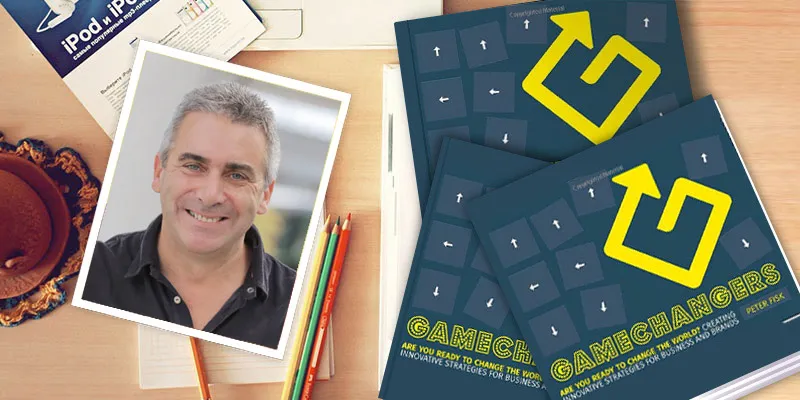Top 7 marketing trends for 2016 – and 10 success tips, from bestselling author Peter Fisk
Peter Fisk is author of the bestseller, Gamechangers: Are you ready to change the world? (see my book review). He heads the company GeniusWorks, and his earlier books include Creative Genius, Customer Genius and People, Planet, Profit.

In the first half of a two-part interview earlier this week, Fisk joined us in an exclusive chat on entrepreneurship trends and tips. In the second part of the interview, he shares with us his views on the Top Trends in marketing and innovation for 2016, as well as ten success tips for innovators and entrepreneurs to ride these trends.
YS: What do you see as the big marketing and innovation trends for 2016?
PF: These are seven trends I developed based on pattern recognition of what the most successful brands are likely to be doing in 2016.
Trend 1 - Space Time: The two biggest priorities for the majority of people today are space and time. Every brand needs to think about how it addresses these two challenges. Not just to reduce time, but to enhance the value of time. Not just to make it smaller, but to make smaller better. The power of your mobile phone lies in the ability not just to talk, but to work, play and learn on the move, anywhere, anytime. The value of a retail store is to do more than just showcase products you can see online, but to interact with people and for people to interact with each other. Space and time also become currency. People will pay more for faster (like Amazon Prime) and smaller (like BMW Mini). For marketers, it’s also about being real time. Forget average ad campaigns, planned months in advance, pushed to everyone when they would prefer to watch the movie on TV. Think about engaging people at the right moment, at the right place, connecting with topical issues right now, or using iBeacons in stores to customise offers to each person, here and now.
Trend 2 - Millennial normality: We hear so much today about how ‘millennials,’ the new generation of youthful consumers, are different. Everything about them challenges the way we think. They are digital natives, they are more global, more caring and reject the conventional practices of the mainstream. Has there ever been a new generation who didn’t? Remember, back in the 1960s, the hippies would change the world, and now that they are the boomers and business leaders, they seem incredibly normal. Add to this, don’t we tell ourselves not to apply stereotypes, and not to segment customers by demographics? The reality is that Gen Y and Gen Z are really quite normal. If anything, Gen Z are quite conservative. They like security, they want families, they drink less, they work out more. Like all of us, they want to make the world a better place, and work from home. Stop being obsessed by millennials, and remember that older people have most of the money to spend!
Trend 3 - Digital gets real: We’ve become addicted to digital. Nothing else is cool. We need an app for everything. But we live in the physical world. Mobile phones connect real people in real places; online shopping allows us to buy physical things with practical applications. The challenge is to connect the two, not to see them as separate channels. To find ways in which digital makes physical experiences better, and vice versa. Nike+ helps you run faster and connect with others. Amazon Dash helps you manage your home. Lego connects you with other builders to help you share your genius, and inspire you to do better (and buy more). 23&Me profiles your DNA for $99 and enables you to directly change your lifestyle and wellbeing. Don’t be blinkered by sexy technology, the marketing challenge is to make it useful, practical, and human.
Trend 4 - Simply better: Simplicity has been described as ‘the ultimate sophistication’ and is certainly not easy. Most things are complex because we are lazy – lazy designers and marketers. We don’t make the effort to really understand what people want and do not, and to decide who we are for, and who not. Instead, we try to meet the needs of everyone, or even the average of nobody, and therefore create complexity. Similarly, we don’t make the effort to make sense of new technologies and processes, to really think about how they can be useful and engaging, and to improve people’s lives. ‘Design thinking’ can be a really powerful approach to uncover the deep and emotional needs of customers, to understand the right problem, and a better way to solve it. It is not research, but much more. Brands from Aldi to Swatch have discovered the magic of simplicity.
Trend 5 - Customers together: Marketers have spent the last 20 years trying to force customers to have a relationship with them. But most don’t want one. They don’t trust you, and you’re not relevant to them. Forget CRM! What customers are interested in is what your products do for them. It’s not the running shoes, but running faster; not the kitchen machine, but cooking great food. And they are also interested in other people like them, who share their passions. The opportunity is for brands to connect people. to facilitate C2C relationships, between, not with, customers. If your brand reflects their passion for running, for cooking, then they will use it like a platform to come together. This might be a physical or virtual ‘community.’ Collaboration then becomes much easier, because they want to co-create.

image: shutterstock
Trend 6 - Automation gets serious: Machines, robotics and artificial intelligence have been developing for a long time. But now they really are taking over many of our traditional processes. Look at any sophisticated factory today. Cars are made entirely by robots. Look at the best customer service centres – 95 per cent of questions can be answered better through algorithms and intelligent programmes. ‘Machine learning’ is making this ability of machines to learn and become more intelligent, even intuitive, a reality. Drone delivery of mail and parcels is only a few years away. This creates speed and efficiency, convenience and personalisation like never before. It also challenges us to find more useful jobs for the people who used to do these things, to find ways in which human beings add more emotional and irreplaceable value.
Trend 7 - China is everywhere: Whilst Western economies struggle to grow at 1 or 2 per cent, China is still growing at 7 per cent, and has by far the largest market of new customers who are discovering brands, and non-essential aspirations, for the first time. The opportunity is to reach out to this huge market, but also to recognise the growth of Chinese companies. Haier, for example, is now the world’s largest white goods company, and probably the most innovative too. Just look at their Coda pocket washing machine. Tom Cruise’s latest Mission Impossible movie is entirely funded by Chinese investors. Therefore, we can all learn from Chinese innovation, partner with Chinese companies, even locally, and also seek their investment to allow us to grow our own businesses faster and further.
YS: You’ve researched and published extensively about marketing and innovation - what are your tips to the innovators and startups in our audience?
PF: Here are my 10 tips:
Tip 1 - Business is about people: Create what customers really want, and then work with your team to deliver it. We are all experts on people. There is no PhD for common sense. What you need is the confidence to think like a human being, to be intuitive and emotional, to challenge the old conventions, and use your imagination. All the tools and techniques of business will help, but the starting point is to be human.
Tip 2 - Listen to customers: When did you last spend a whole day observing, listening and talking to your clients or consumers? Design thinking is all about diving deeper into the world of the customer. Don’t just ask them to tick boxes in a questionnaire. Try to work out what their real problems are, their dreams, their frustrations. Do it every week. Really. You are never ‘too busy.’ And harness the right insights.
Tip 3 - The best ideas are out there: The great ideas are probably not in your own geographical market, or business sector, but in other categories and countries. Don’t just sit there trying to be slightly better, or slightly cheaper than your competitors. Instead, look to other places, where ideas are already being used (it’s like a free research lab), which you can take and apply to your own business.
Tip 4 - Make new connections: That is how Leonardo da Vinci described innovations. Therefore, look for things which don’t connect, which seem like opposites, even a paradox, then find a way to resolve them. For example, take the Airbnb model of sharing and apply it to your business, what do you get? Or the subscription model of Zipcars, or the freemium model of Spotify. Take two different products and try combining them together.
Tip 5 - Together is better: The power of a team will always triumph over lone genius. It’s amazing how we still think we can do better alone. Use the power of diversity to achieve more, each person only has part of the answer, it is the diversity of their knowledge and experiences that beats any one person. Facilitate this carefully (this is a real skill), to bring out the best in everyone, to integrate and shape it together.

image: shutterstock
Tip 6 - Networks are exponential: Businesses don’t need all the capabilities themselves, it’s about finding the right partners to do each task better, and to bring all the partners together as an ecosystem. It is then about reaching markets through networks – social, chains, licensing. Networks can multiply your business much further and faster exponentially.
Tip 7 - The power of one page: The one-page strategy, the one-page business case, the one-page project pitch, the one-page marketing strategy. People are incredibly busy, and attention is scarce, so being able to bring things together in one page is incredibly powerful (maybe it’s one page of text, or an infographic, or a rich picture, or even a poster). It is also a great discipline, to get you to focus on what matters, and articulate it clearly.
Tip 8 - Be the Gamechanger: The big idea of my new book Gamechangers is to not to simply innovate the product or service (because it will be copied before you launch it!) but to innovate the market (the ‘game’: how it works, the price points, the channels, the rules), and then innovate the business (especially the business model: how you will work to make money in the new game). Start from the market, then work inwards.
Tip 9 - Don’t be afraid: I often start a consulting project having no idea what the solution might be, or exactly how to get there. The skill is to have the confidence to get started, and to adapt as you learn more about the problem, and your solution develops. Build a prototype early – a picture, a cardboard model, or a real quick solution – which allows people to focus on something and make it better.
Tip 10 – “10x not 10 per cent”: What I learnt from Google’s X Labs is the power of thinking bigger. Being audacious. Most of us keep looking for the 10 per cent improvement (to make products 10 per cent better, to drive 10 per cent more sales than last year). Incrementalism makes us lazy, and we always seek to squeeze a little more out of the old, outdated thinking. Instead, think from the future back, with bigger and bolder ideas, then work towards them.
YS: What is your parting message to the startups and aspiring entrepreneurs in our audience?
PF: Be bold. Be brave. Be brilliant.






